If you’re a cat lover, you’ve likely pondered the inner workings of your feline friend’s mind. One moment they’re exhibiting bafflingly goofy behavior, the next they’re demonstrating an almost uncanny ability to navigate your home in complete darkness, perhaps even “gifting” you with a toy mouse at an inconvenient hour. This leads to a natural curiosity: just how intelligent are cats, and how does their brain size play a role?
So, how big is a cat’s brain really? In terms of physical dimensions, a cat’s brain is approximately 2 inches in length and weighs about an ounce. This means a cat’s brain makes up roughly 1% of its total body weight. But brain size is just the beginning of the story. Let’s delve deeper into the fascinating world of feline neurology to understand how cats utilize their brains and senses to navigate their world.
 divider 2 cats
divider 2 cats
Exploring the Size of a Cat’s Brain
Alt Text: Infographic comparing the size of a cat brain to a human brain, highlighting relative size and neuron count for educational purposes.
When comparing brain sizes across species, it’s true that a dog’s brain is generally larger than a cat’s. To visualize this, a cat’s brain is often compared to the size of a walnut, while a dog’s brain is closer to a tangerine. However, size alone isn’t the definitive measure of intelligence. The complexity of brain structures and the degree of surface folding (gyrification) are more critical indicators of cognitive ability.
Interestingly, cats possess a brain structure that shares more similarities with humans than with dogs. In fact, feline brains are remarkably 90% structurally identical to human brains. This surprising similarity might give you pause the next time you contemplate your cat’s intelligence and behavior!
However, before you start envisioning a feline-led world domination, it’s crucial to consider the significant difference in neuron count, particularly in the cerebral cortex. While cats boast around 300 million neurons, humans have a staggering 21 to 26 billion neurons in the same cerebral cortex region.1 This difference in neuronal density plays a critical role in complex cognitive functions.
Furthermore, even when comparing cats to dogs, neuron distribution varies. Dogs tend to have a higher neuron count overall, likely due to their larger brain size. In terms of specialization, dogs exhibit more development in the social cognition areas of their cerebral cortex, which aligns with their pack-oriented nature. Conversely, cats have a greater proportion of their cerebral cortex dedicated to movement and vision, reflecting their solitary hunting and predatory skills. This neurological specialization explains why cats and dogs excel in different domains.
 orange cat lying on bed
orange cat lying on bed
How Cats Leverage Their Brainpower in Daily Life
Your cat’s brain acts as the central command center, regulating every facet of their existence. It’s the driving force behind many of their characteristic behaviors, including their crepuscular nature. Crepuscular animals, like cats, are most active during dawn and twilight hours. This activity pattern is an evolutionary adaptation that allows them to effectively hunt prey that are also most active during these low-light periods. Examples of other crepuscular creatures include deer, opossums, hamsters, and skunks.
This innate crepuscular rhythm explains why your feline companion might decide to rouse you from sleep in the pre-dawn hours. It’s not intentional mischief; it’s deeply ingrained instinct. They’re operating on their natural biological clock, not plotting your early morning wake-up call!
Beyond their activity cycles, cats also exhibit unique behavioral patterns compared to canines, particularly concerning hunting. Unlike dogs, who typically cease hunting after they’ve eaten, outdoor cats will often continue to hunt even when satiated. This surplus hunting behavior is thought to be linked to their evolutionary need to hone their hunting skills and potentially cache prey for later.
The Remarkable Five Senses of a Cat
It’s truly impressive what cats can perceive and achieve with a brain that weighs only an ounce. Their brains are wired to maximize the use of their highly refined senses, enabling them to thrive in their environment as skilled predators and adaptable companions. Let’s explore each of the five senses in detail:
1. Keen Eyesight
Alt Text: Detailed infographic illustrating the anatomy of a cat’s eye, highlighting features like the tapetum lucidum for enhanced night vision.
Cats possess exceptional vision, especially in low-light conditions. A key adaptation is the tapetum lucidum, a reflective layer behind the retina. This structure acts like a mirror, bouncing light photons back onto the retina, giving photoreceptor cells a second chance to capture light. This is why cats’ eyes seem to glow in the dark and significantly enhances their night vision.
Furthermore, cats have a higher concentration of rod cells in their retinas compared to humans. Rods are photoreceptor cells that are highly sensitive to dim light, enabling superior vision in darkness. Conversely, cats have fewer cone cells, which are responsible for color vision and acuity in bright light. This difference in rod and cone distribution means that while cats excel in night vision, their color perception is different from humans, primarily seeing in shades of blue, yellow, and gray.
2. Selective Taste
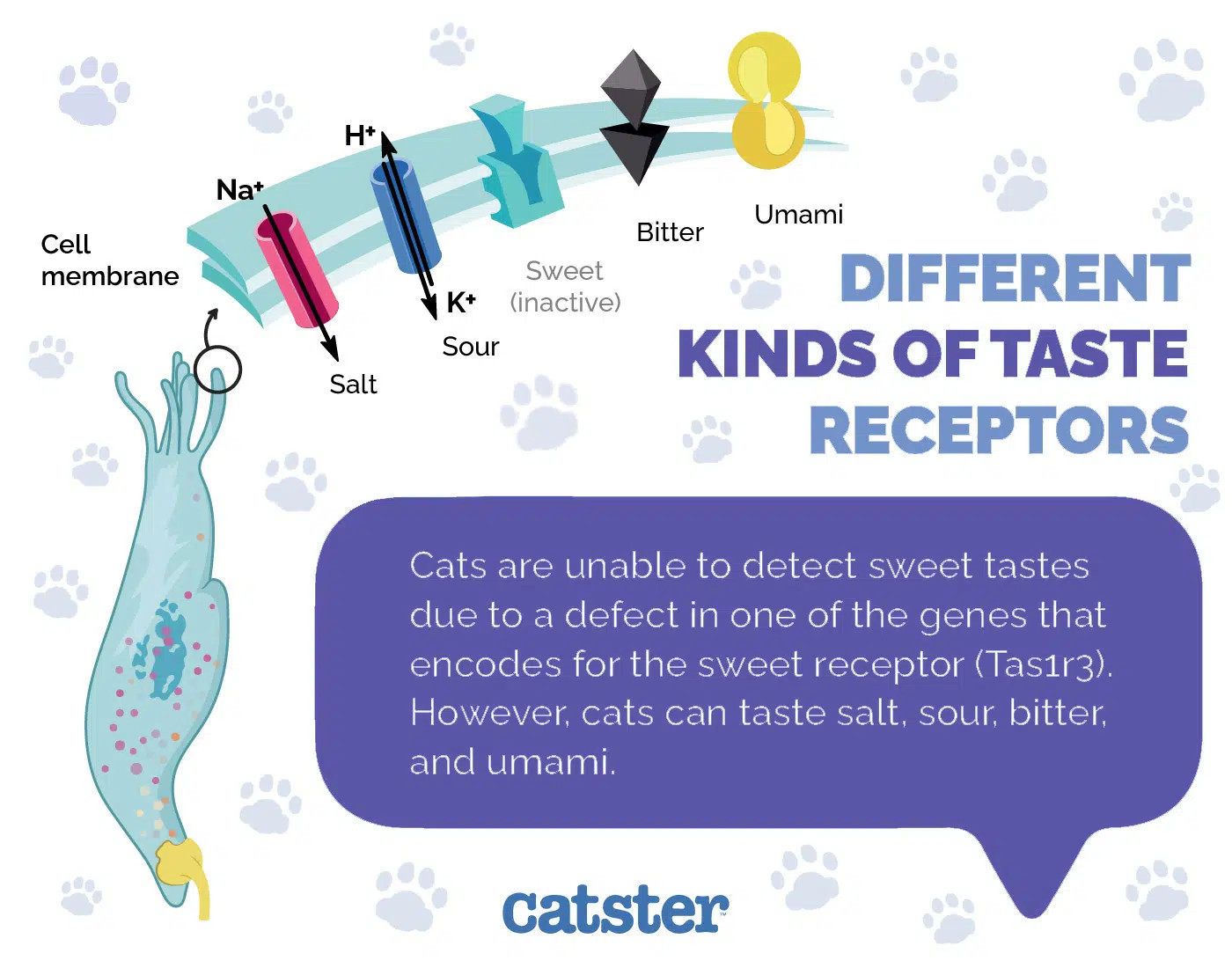 Different Kinds of Taste Receptors
Different Kinds of Taste Receptors
The feline sense of taste is quite different from ours. Humans have around 9,000 taste buds, while cats have only a few hundred. Most notably, cats appear to lack the taste receptors for sweetness. If your cat shows interest in sweet treats like whipped cream or ice cream, it’s likely not the sugar they crave but rather the high-fat content that attracts them.
Cats, however, are highly sensitive to bitter tastes. This heightened sensitivity is an evolutionary advantage, as it helps them detect potentially toxic or poisonous substances in the wild. This aversion to bitterness is why lemon sprays can be effective deterrents for keeping cats away from certain areas.
3. Acute Hearing
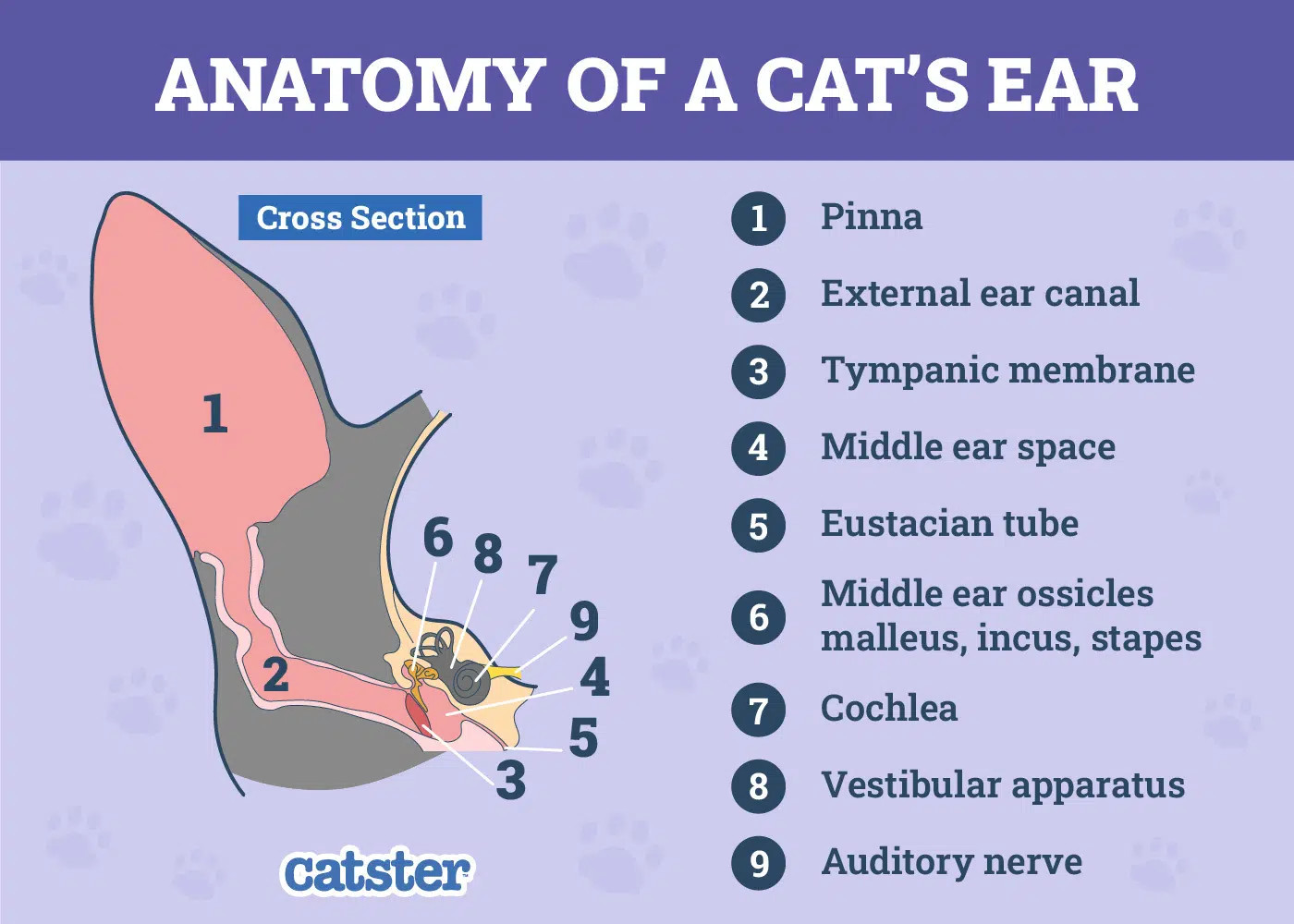 Anatomy of Cats Ear
Anatomy of Cats Ear
A cat’s hearing is exceptionally sharp and plays a crucial role in their awareness of their surroundings and hunting prowess. Their pinnae, the visible outer ears, are cone-shaped and highly mobile. This shape helps funnel sound waves into the middle ear, and their mobility allows cats to independently rotate their ears 180 degrees. This remarkable ear mobility enables them to precisely pinpoint the location of sounds, essential for detecting prey or potential threats.
4. Sensitive Touch
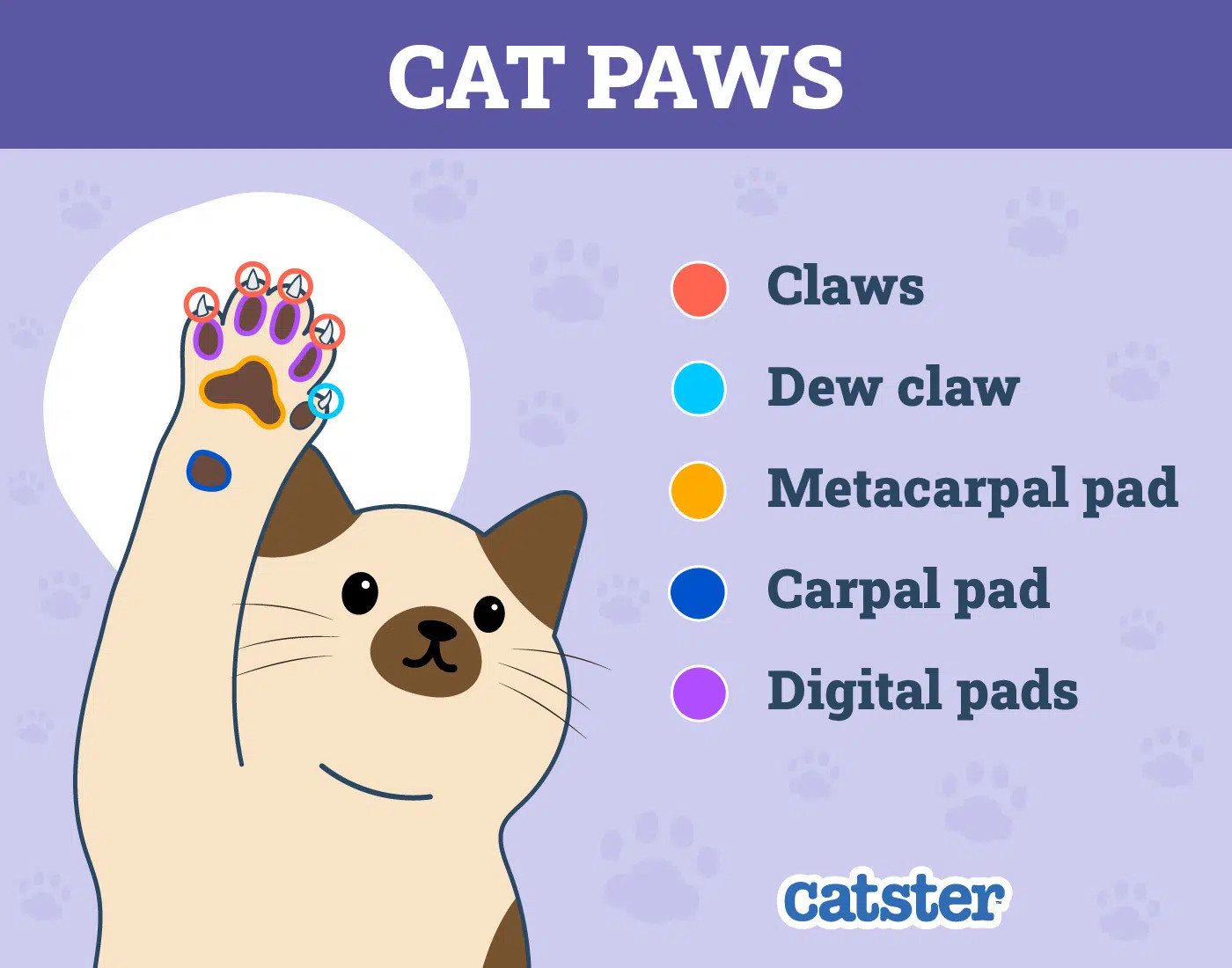 Alt Text: Infographic detailing cat paw anatomy, focusing on touch receptors in paws and whiskers as sensory tools for navigation and tactile exploration.
Alt Text: Infographic detailing cat paw anatomy, focusing on touch receptors in paws and whiskers as sensory tools for navigation and tactile exploration.
Touch is another vital sense for cats, providing them with detailed information about their environment. Their whiskers (vibrissae) are highly specialized touch receptors. These stiff hairs are not just for show; they are deeply rooted with nerve endings that transmit information about air currents and physical contact. Whiskers are particularly important for navigation in tight spaces, helping cats determine if they can fit through narrow openings.
Beyond whiskers, cats also have touch receptors in their paws and nose. These receptors are sensitive to pressure and texture, allowing cats to gather information about surfaces and objects through touch.
5. Powerful Sense of Smell
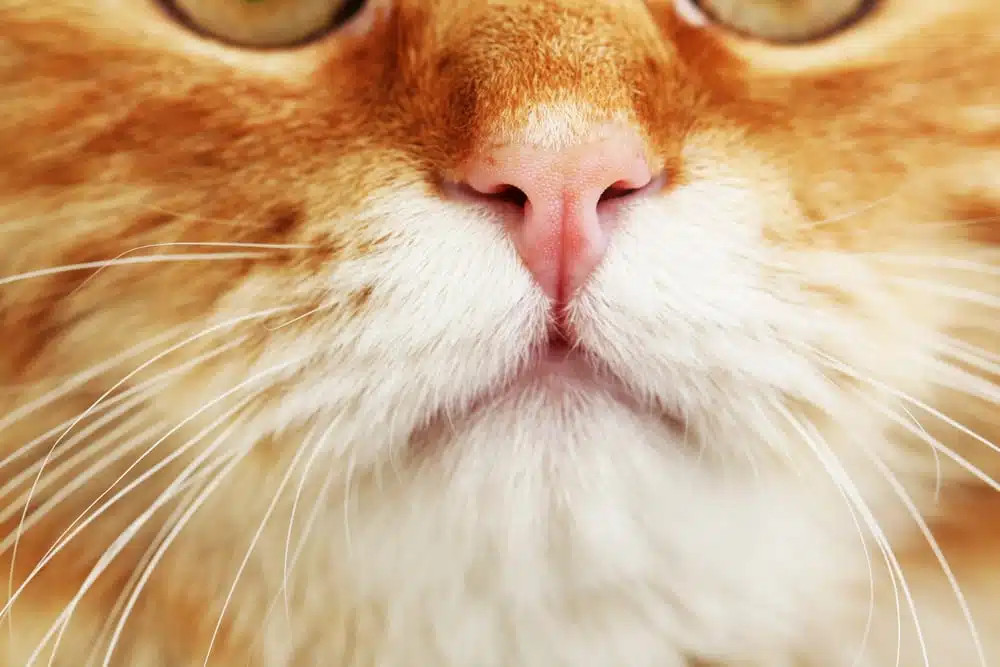 cat nose
cat nose
Cats heavily rely on their sense of smell, which is far more developed than humans’. Their olfactory senses are crucial for food detection, social communication, and environmental awareness. If a cat experiences a respiratory infection that impairs their sense of smell, it can significantly impact their appetite, often leading to food refusal.
Cats also possess a unique olfactory structure called the vomeronasal organ (Jacobson’s organ). Located in the roof of their mouth, just behind their upper incisors, this organ is specifically designed to detect and process pheromones. Pheromones are chemical signals that cats (and many other animals) use for communication. Cats produce pheromones from various glands, including those located between their toes and in their anal glands, using these scents to mark territory, attract mates, and communicate social status.
Frequently Asked Questions (FAQ)
What Are the Key Components of a Cat’s Brain?
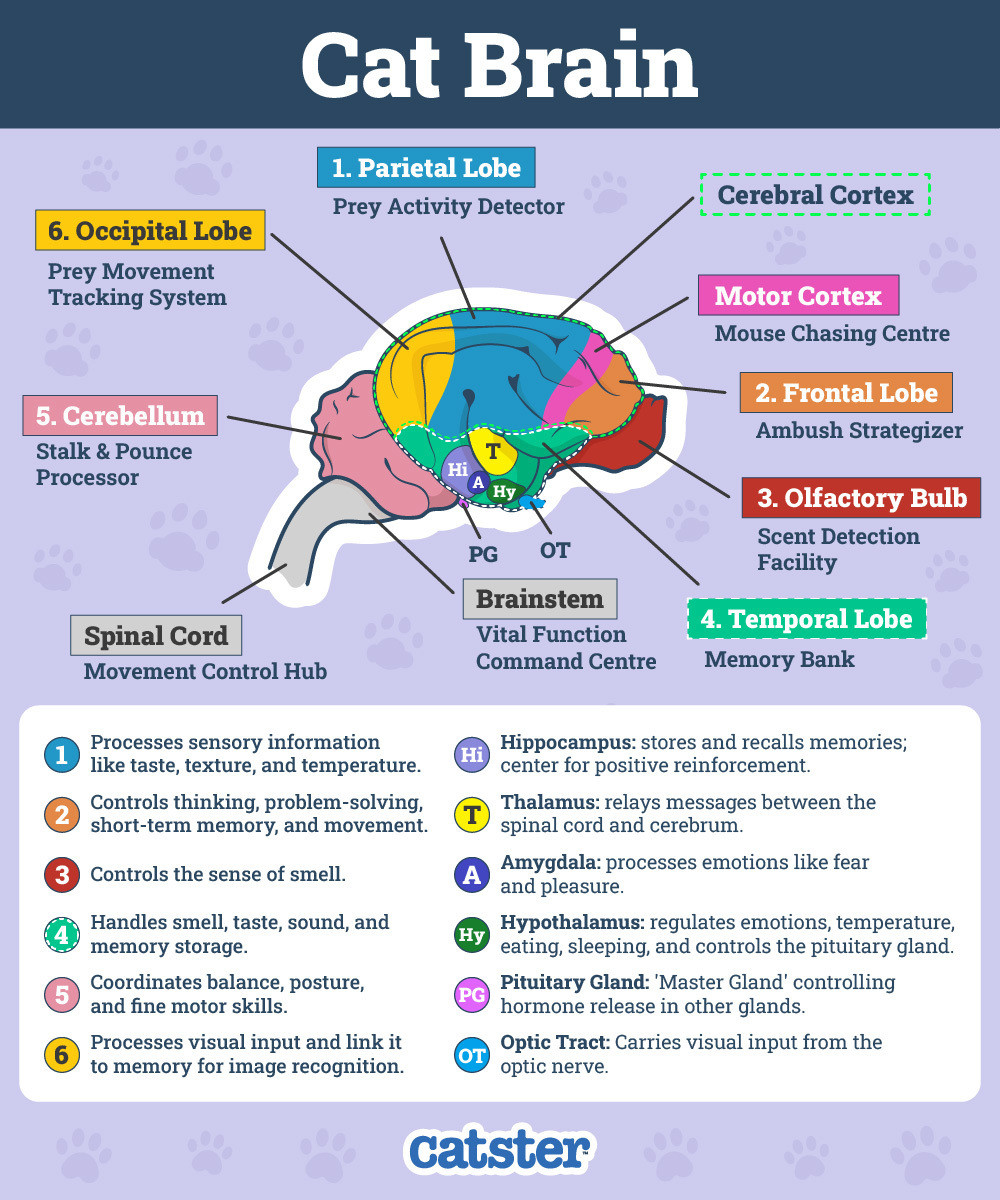 Cat Brain Parts
Cat Brain Parts
Like humans, cats have a central nervous system (CNS) composed of two main parts:
- The brain: The control center for all bodily functions, senses, and cognitive processes.
- The spinal cord: A long bundle of nerves extending from the brain, transmitting signals throughout the body.
The brain itself is further divided into major sections, each with specific functions. The primary parts of the cat brain include:
- The cerebellum: Responsible for coordinating movement, balance, and posture.
- The cerebrum: The largest part of the brain, involved in higher-level functions like learning, memory, and sensory processing.
- The brainstem: Connects the brain to the spinal cord, regulating essential life functions such as breathing, heart rate, and sleep-wake cycles.
Are Domestic Cats Evolving to Be Less Intelligent?
While it’s challenging to directly measure changes in feline intelligence over generations, scientists have studied the evolution of cat brain size. Intriguingly, research suggests that domestic cats may have experienced a reduction in brain size compared to their wild ancestors, the European and African wildcats.
One study indicates that domestic house cats might have undergone a 25% decrease in brain size relative to their wildcat cousins. This reduction is theorized to be linked to domestication. In a safe, human-provided environment, the intense survival pressures faced by wildcats are lessened. This relaxed selection pressure may have led to a decrease in brain size, as the cognitive demands for survival in the wild (hunting, predator avoidance, complex social interactions in some wild species) are less critical for domesticated cats.
